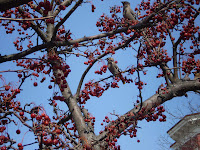
The destruction of our environment can be greatly attributed to our human disconnect with nature and for many of us living in urban areas that disconnect seems great at times. Having been raised in rural Maine I am amazed that our urban landscape is actually vibrantly inhabited with wildlife and this is especially true this spring. This season awakens us with its unique smells and sounds that remind us we survived another long, cold winter. Hopefully we all had some fun with all the snow we had; there is always something to cherish in every season. I ride my bike, even on the coldest of nights. The reward I got this winter from enduring the nightly climb up Munjoy Hill and the salt spray from Congress St. was being witness to an amazing gathering of hundreds of crows that seemed to have come from every direction. I stopped my bike in front of Lincoln Park and was awe struck at the shear numbers of birds above me. The trees became laden with corvids, making the passing cars virtually inaudible. I was perplexed by their choice to roost right in the middle of a busy, brightly lit urban intersection, so I went in search of an answer. One of my literary heros, Bernd Heinrich, in his book "Winter World", stated that he too had been perplexed by this phenomenon. He concluded that these communal winter roosts allowed for safety in numbers and communication about food resources. Most importantly, he believed that they choose to roost in urban centers instead of the forest to avoid their greatest predator the great horned owl! It was great to know that our city was a sanctuary for some of our animal friends. Now that the snow cover is receding and temperatures are rising, Portland is once again home to some of our migratory friends and a breeding ground for some of our resident birds. The cardinals can now be heard singing their beautiful songs and because of their magnificent red color are easily seen with the naked eye. Cardinals are a year round resident of Maine, but you wouldn't know since they are very quite during the winter months. Surprisingly both males and females sing. They breed March through September usually producing two broods a year. I've spotted Bohemian waxwings in the East End. They are pictured in the photo above. Bohemian waxwings are highly migratory, hence their name, so now is the time to spot these birds. They are frugivores, feeding primarily on fruit, and sometimes insects in the summer. You can spot them in fruit trees that still have fruit hanging from them. Last week I saw a group feeding on cherries at the corner of India and Congress. Walking by the same tree a few days later I noticed the tree was bare and their discarded berries were on the ground below. I have also spotted a red tailed hawk on Hammond street and many of us probably saw the barred owl in Longfellow Square. Unfortunately, seeing barred owls in the city is evident that the birds are starving and are coming to urban areas because of the lack of food elsewhere. The couple at Avian Haven, a bird rehabilitation center in Freedom, Maine, reported that the barred owls food source was scarce this winter. They suggested that is was probably due to the increase in numbers of barred owls that migrated here from Canada when a virus decimated the vole population there. Although it was exciting to see a barred owl right in the city it was also saddening to know the reason. For those of you that are able to get out of the city, Two Lights State Park near Crescent Beach is a good place to spot the exquisitely colored harlequin ducks. They can be seen riding the surf along with their neighbors the common eider. So if you're feeling low and want evidence that Spring is here, take a walk in your neighborhood. If you go openly and freely with little expectation, I guarantee nature will speak. Let us begin healing our relationship with nature. For more information on these creatures visit www.avianhaven.org or www.maineaudubon.org

